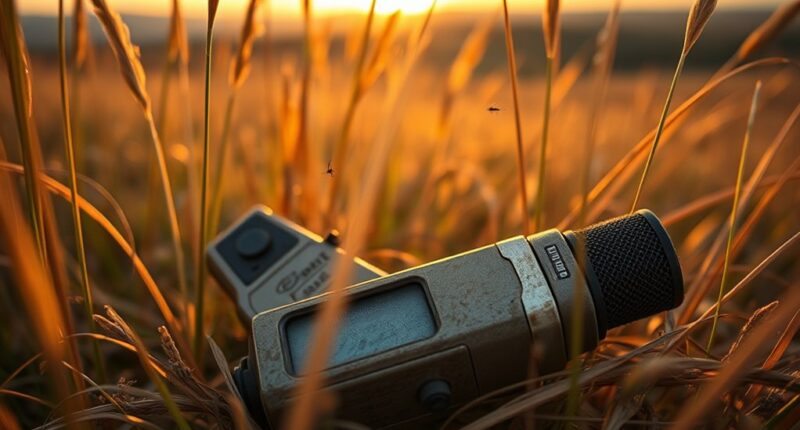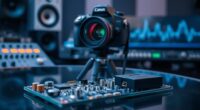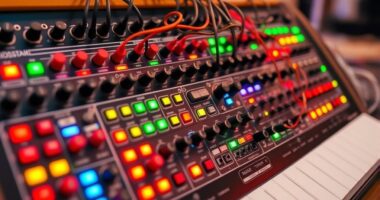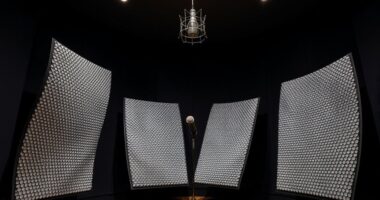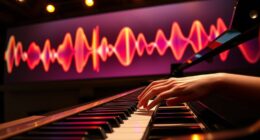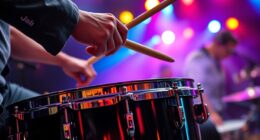To turn everyday noise into hits on a budget, start with affordable gear like a reliable portable recorder and a versatile microphone, such as a shotgun or small stereo mic. Pay attention to your environment for interesting sounds, positioning your mic close without contact and using techniques like windshields. Use free editing software to clean and enhance your recordings. With some creativity, your simple captures can become compelling soundscapes—continue exploring for even more tips.
Key Takeaways
- Use affordable, portable recorders with good preamps and versatile microphones like shotgun or small stereo mics.
- Pay attention to ambient sounds and subtle noises in your environment for unique recordings.
- Position microphones close to the source, using directional mics and windshields to capture clear, dynamic audio.
- Edit recordings with free software like Audacity to trim, reduce noise, and enhance sound quality.
- Incorporate everyday sounds creatively into projects by layering, manipulating, or using them as textures.
Choosing the Right Equipment for Budget Field Recording

When you’re working with a limited budget, selecting the right equipment can make all the difference in capturing high-quality field recordings. Focus on essential gear like a reliable recorder and a decent microphone. You don’t need the most expensive gear to get good results; many affordable options deliver excellent sound quality. Look for a portable recorder with good preamps and decent battery life. For microphones, consider a versatile shotgun or a small stereo mic, which can handle various environments. Avoid unnecessary accessories that inflate costs—prioritize what truly enhances your recordings. Research user reviews and sample recordings before purchasing. Choosing equipment with multi-functionality can help you get the most out of your budget. Additionally, understanding the technical specifications of your gear will ensure better performance and durability. Being familiar with sound quality metrics can guide you in selecting the best options within your price range. Incorporating versatile equipment can also maximize your recording capabilities in different environments. With careful selection, you can build an effective recording kit without breaking the bank, ensuring you’re prepared to capture clear, detailed sounds wherever you go.
Identifying Interesting Sound Sources Around You
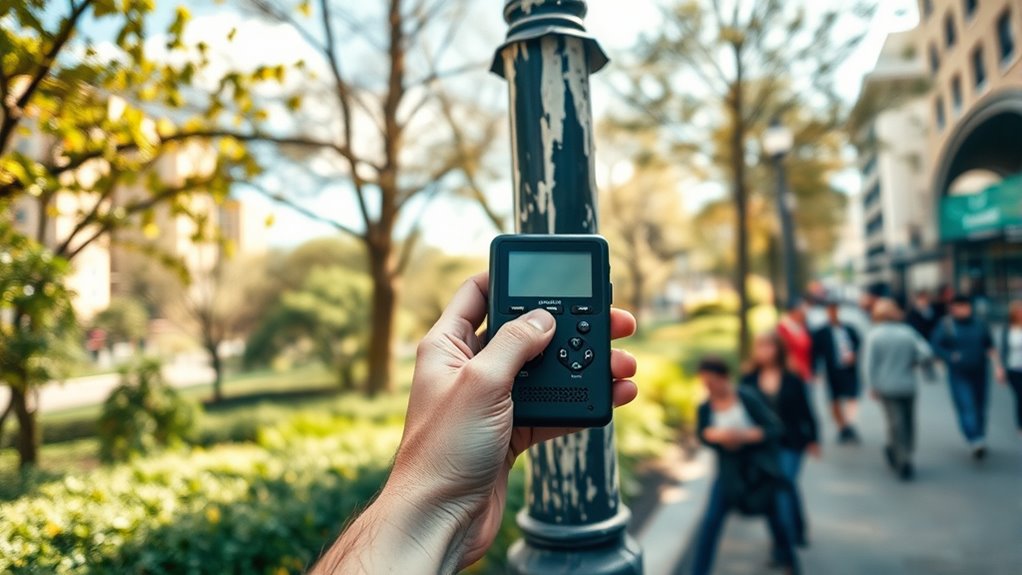
Discovering interesting sound sources around you starts with paying close attention to your environment. Walk slowly and listen carefully, noting even subtle noises. Pay attention to everyday sounds like the hum of a refrigerator, distant traffic, footsteps, or birdsong. Look for unique or rhythmic sounds that stand out. Keep a mental or physical note of locations where sounds change or become more vibrant. Explore different times of day; morning and evening often bring new sounds. Don’t dismiss background noises—they can add texture to your recordings. Use your intuition to identify sounds that evoke emotion or curiosity. Developing an awareness of ambient sound environments can enhance your recordings spiritual practices and their impact on well-being. Engaging in mindful listening can also help you notice sound environment variability, revealing subtle acoustic details. With practice, you’ll develop a keen sense for capturing compelling sounds right in your own environment.
Techniques for Capturing Clear and Dynamic Recordings
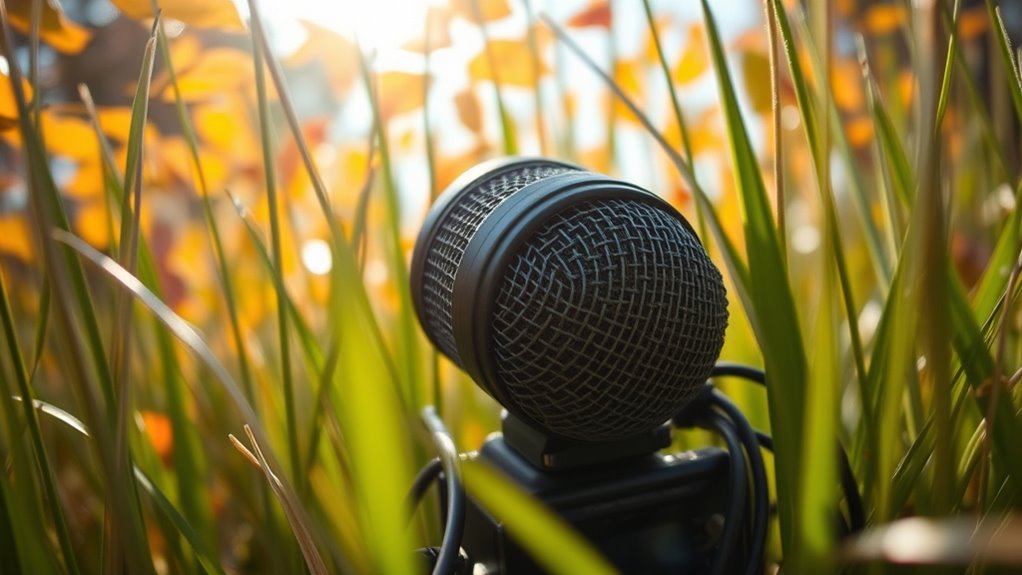
To capture clear and dynamic recordings, you need to master proper microphone placement and settings. Position your mic close to the sound source without touching it, ensuring it picks up the desired audio clearly. Use a directional microphone, like a shotgun or cardioid, to focus on specific sounds and reduce background noise. Adjust the gain so the loudest sounds don’t distort, but the quieter ones are still audible. Keep the microphone steady, or use portable stands to avoid handling noise. Record in a quiet environment or choose outdoor spots with minimal wind. If possible, add a windscreen to prevent wind noise. Experiment with different angles and distances to find the sweet spot that captures both clarity and depth. Incorporating automation technologies can help manage audio levels more consistently during recordings, especially in variable environments. Additionally, understanding sound source localization techniques can further improve the focus and quality of your recordings. Exploring microphone polar patterns can also help you select the best microphone for your recording situation and improve sound isolation. Being aware of GMC tuning methods can also help optimize your equipment settings for the best results.
Editing and Enhancing Your Recordings With Free Tools
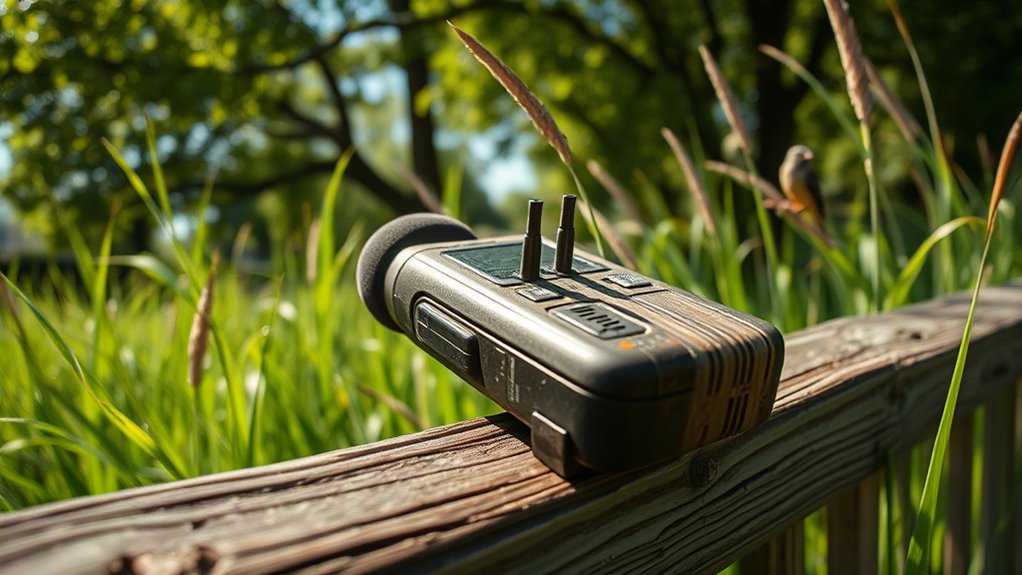
Once you’ve captured your recordings, the next step is to polish them using free editing tools that are accessible to everyone. Start by importing your audio into free software like Audacity or Ocenaudio. These programs let you trim unwanted sections, reduce background noise, and adjust volume levels easily. Use noise reduction features to clarify your recordings, removing hums or hiss without sacrificing quality. Equalization (EQ) can help enhance specific sounds or tone down harsh frequencies. Applying gentle fades at the beginning and end prevents abrupt cuts. Additionally, experimenting with compression can make your sounds more balanced and punchy. These tools empower you to refine your recordings professionally, all without spending a dime, making your everyday noises sound more polished and ready for your projects.
Creative Ideas for Using Everyday Sounds in Your Projects

Everyday sounds hold surprising potential for creative projects, from adding depth to your audio compositions to creating immersive soundscapes. You can incorporate the hum of a coffee shop or distant traffic to evoke a specific mood or setting. Use household noises like tapping, clattering, or door creaks to add unique textures to your tracks. Record the rhythm of footsteps or the rustle of leaves to create natural percussion or ambient layers. Experiment by manipulating these sounds—speeding up, slowing down, or applying effects—to transform them into entirely new elements. Don’t hesitate to layer multiple recordings for richness or isolate snippets for subtle accents. With a little creativity, your everyday environment becomes a versatile toolkit for making your projects stand out.
Frequently Asked Questions
How Can I Improve Sound Quality Without Expensive Gear?
If you want to improve sound quality without splurging on expensive gear, focus on your environment and technique. Use a quiet space, minimize background noise, and get close to your sound source. Experiment with positioning your microphone for the best tone. You can also invest in affordable accessories like foam windshields or DIY shields. Ultimately, edit your recordings with free software to enhance clarity and reduce unwanted noise.
What Are the Best Locations for Capturing Unique Sounds?
Think of capturing sounds like fishing—you want the right spot for the best catch. You should explore urban parks, busy markets, or quiet alleyways, as each offers unique noises that tell a story. I once recorded street musicians in a subway station—an echo chamber of life. Seek locations with varied activity, natural acoustic properties, and minimal background noise for the most compelling recordings.
How Do I Avoid Background Noise Interference?
To avoid background noise interference, you should choose quiet times and locations, like early mornings or secluded areas. Use a directional microphone to focus on your desired sound and minimize unwanted noise. Keep your equipment close to the sound source and use windshields or foam covers to reduce wind noise. Finally, monitor recordings with headphones and re-record if background noise is too distracting, ensuring clean, clear captures every time.
Are There Legal Considerations When Recording in Public?
Imagine the legal landscape as a vast, uncharted river you must navigate carefully. When recording in public, you’re often required to respect privacy laws and obtain permissions if you’re capturing identifiable individuals or private property. Always be mindful of local regulations, and when in doubt, seek consent or avoid intrusive recordings. This way, your creative journey remains a smooth voyage, steering clear of legal whirlpools.
How Can I Organize and Store My Recordings Efficiently?
To organize and store your recordings efficiently, start by creating clear folders for different projects or locations. Use descriptive names and dates to easily identify files later. Invest in a reliable external hard drive or cloud storage to back up your work regularly. Consider using audio management software to tag, categorize, and search your recordings quickly. This way, your collection stays tidy, accessible, and safe.
Conclusion
With a little curiosity and creativity, you can transform everyday noise into mesmerizing sounds that breathe life into your projects. Remember, the best recordings often come from the simplest sources—your surroundings are full of hidden melodies waiting to be discovered. So, grab your gear, embrace the chaos, and turn the ordinary into extraordinary. After all, isn’t it the unexpected that often makes your work truly unique? Let your ears lead the way and start capturing today.
